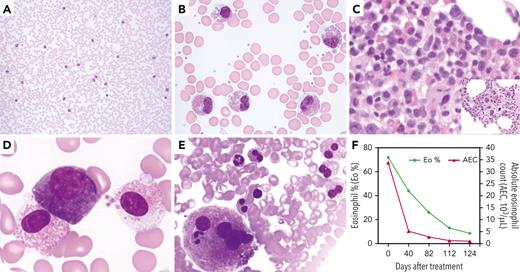A 67-year-old woman presented with persistent eosinophilia. Complete blood count showed leukocytosis (40 200/μL), anemia (10.6 g/dL), and thrombocytosis (742 000/μL). Peripheral blood smear displayed increased eosinophils (74%; panel A; Wright-Giemsa stain; original magnification ×200), often with dysplasia, including uneven granules and cytoplasmic vacuoles (panel B; Wright-Giemsa stain; original magnification ×500). Bone marrow biopsy showed hypercellular (60%) marrow with marked eosinophilic proliferation (panel C; hematoxylin and eosin stain, original magnification ×400), decreased erythropoiesis, and dysplastic megakaryocytes (panel C inset; original magnification ×200). Bone marrow aspirate smears demonstrated eosinophilia (panel D; Wright-Giemsa stain; original magnification ×1000), dysplasia in eosinophils (panel D) and megakaryocytes (panel E; Wright-Giemsa stain; original magnification ×500), and ring sideroblasts (12%). No aberrant T cells were identified by flow cytometry. Chromosomal analysis showed 47,XX,+8[7]/47,idem,del(5)(q23q31)[9]. No rearrangements of tyrosine kinase gene loci were identified by optical genome mapping. Next-generation sequencing revealed JAK1 p.R629_D630del (variant allele frequency [VAF] 35%), DNMT3A p.E745fs (VAF 33%), and SF3B1 p.K700E (VAF 41%). The differential diagnosis includes myelodysplastic/myeloproliferative neoplasm with SF3B1 mutation and thrombocytosis; however, given the marked leukocytosis/eosinophilia and decreased erythropoiesis, the diagnosis of chronic eosinophilic leukemia (CEL) was favored. Treatment with the JAK1/2 inhibitor ruxolitinib and the hypomethylating agent azacitidine led to a rapid, significant decrease in eosinophils (panel F).
JAK1 mutations are often seen in T-cell lymphoma/leukemia but have been reported only once in a case of CEL. To our knowledge, this is the first report of a patient with JAK1-mutated CEL and sensitivity to ruxolitinib.
For additional images, visit the ASH Image Bank, a reference and teaching tool that is continually updated with new atlas and case study images. For more information, visit https://imagebank.hematology.org.


